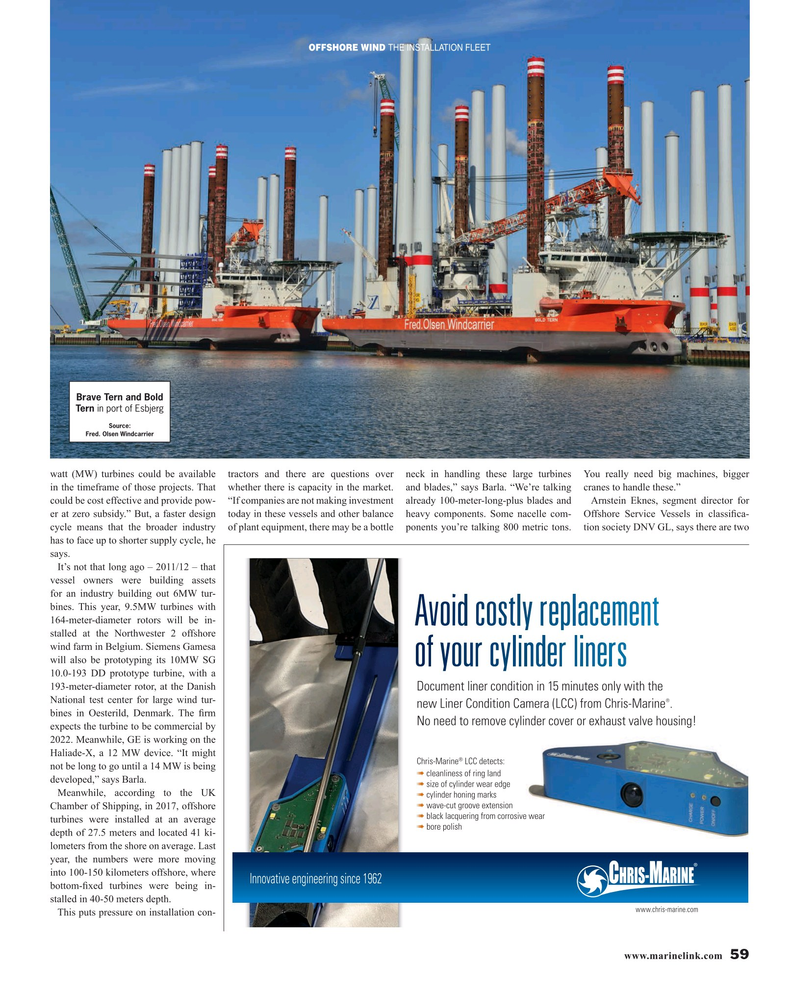
Page 59: of Maritime Reporter Magazine (November 2019)
Workboat Edition
Read this page in Pdf, Flash or Html5 edition of November 2019 Maritime Reporter Magazine
OFFSHORE WIND THE INSTALLATION FLEET
Brave Tern and Bold
Tern in port of Esbjerg
Source:
Fred. Olsen Windcarrier watt (MW) turbines could be available tractors and there are questions over neck in handling these large turbines You really need big machines, bigger in the timeframe of those projects. That whether there is capacity in the market. and blades,” says Barla. “We’re talking cranes to handle these.” could be cost effective and provide pow- “If companies are not making investment already 100-meter-long-plus blades and Arnstein Eknes, segment director for er at zero subsidy.” But, a faster design today in these vessels and other balance heavy components. Some nacelle com- Offshore Service Vessels in classi? ca- cycle means that the broader industry of plant equipment, there may be a bottle ponents you’re talking 800 metric tons. tion society DNV GL, says there are two has to face up to shorter supply cycle, he says.
It’s not that long ago – 2011/12 – that vessel owners were building assets for an industry building out 6MW tur- bines. This year, 9.5MW turbines with 164-meter-diameter rotors will be in- stalled at the Northwester 2 offshore wind farm in Belgium. Siemens Gamesa will also be prototyping its 10MW SG 10.0-193 DD prototype turbine, with a 193-meter-diameter rotor, at the Danish
Document liner condition in 15 minutes only with the ®
National test center for large wind tur- new Liner Condition Camera (LCC) from Chris-Marine . bines in Oesterild, Denmark. The ? rm
No need to remove cylinder cover or exhaust valve housing!
expects the turbine to be commercial by 2022. Meanwhile, GE is working on the
Haliade-X, a 12 MW device. “It might ®
Chris-Marine LCC detects: not be long to go until a 14 MW is being ¯ cleanliness of ring land developed,” says Barla.
¯ size of cylinder wear edge
Meanwhile, according to the UK ¯ cylinder honing marks ¯ wave-cut groove extension
Chamber of Shipping, in 2017, offshore ¯ black lacquering from corrosive wear turbines were installed at an average ¯ bore polish depth of 27.5 meters and located 41 ki- lometers from the shore on average. Last year, the numbers were more moving into 100-150 kilometers offshore, where
Innovative engineering since 1962 bottom-? xed turbines were being in- stalled in 40-50 meters depth. www.chris-marine.com
This puts pressure on installation con- www.marinelink.com 59
MR #11 (59-65).indd 59 10/29/2019 11:31:31 AM

 58
58

 60
60
